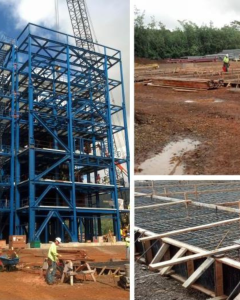 Structural engineering is often the invisible backbone of a building. Once construction is complete, the critical work that keeps a structure standing—supporting daily use and withstanding weather and external forces—is hidden behind walls and finishes. Unlike plumbing or carpentry finishes that are seen and used every day, structural engineering elements are not something we see in a building, but we rely on them daily. It’s easy to take for granted how essential their work is, but structural engineers are vital in keeping our buildings safe, durable, and built to last.
Structural engineering is often the invisible backbone of a building. Once construction is complete, the critical work that keeps a structure standing—supporting daily use and withstanding weather and external forces—is hidden behind walls and finishes. Unlike plumbing or carpentry finishes that are seen and used every day, structural engineering elements are not something we see in a building, but we rely on them daily. It’s easy to take for granted how essential their work is, but structural engineers are vital in keeping our buildings safe, durable, and built to last.
This vital role is why, on every construction project, there is someone to ensure it’s built safely and correctly: the Structural Engineer of Record (SER). They oversee a building’s structural integrity, ensuring that designs are executed correctly and that all work complies with safety standards and local building codes.
The role of a structural engineer of record
A structural engineer is responsible for designing and analyzing the load-bearing framework of a building or structure. This includes everything from foundations and columns to beams and load-distribution systems. However, the SER—the Structural Engineer of Record—is the licensed professional who takes legal and professional responsibility for the structural design. That means that they:
- Develop structural designs and construction documents
- Ensure compliance with local building codes and safety regulations
- Coordinate with architects, civil engineers, and MEP (mechanical, electrical, and plumbing) engineers
- Review shop drawings and submittals during construction
- Perform site observations and respond to RFIs (Requests for Information) from contractors
- Provide stamped and signed drawings for permit approvals
When acting as the SER, engineers guide a project from the design phase to finished construction and ensure that it’s safe and built correctly. But they do more than shepherd the work along. They also take the legal responsibility for ensuring the project is safely completed. They approve each design, ensuring it meets safety requirements and building codes, and sign off on it, which makes them legally liable if an issue proves the work was not completed correctly or doesn’t meet safety regulations.
Embracing modern SER tools
Over time, the role of the SER has shifted as new technologies have made collaboration easier. Today’s structural engineers don’t rely solely on blueprints and in-person meetings. Many now use advanced 3D modeling, collaborative cloud platforms, and project management tools to streamline communication and stay connected with global teams. This technological integration is particularly valuable for projects that involve multiple countries, time zones, and construction teams.
Over the past 40+ years, we’ve acted as the SER on several different projects and embraced the tools that make this process more collaborative than ever before. Our structural department uses cutting-edge software and digital tools to act as SERs on projects millions of miles from our Utah home base. We review building plans, assess designs, and sign off as the SER from our office.
Project highlight: Kauai Green Energy Project
A perfect example of how SERs operate in today’s modern world was our work on the Kauai Green Energy project. This $90 million biomass-to-energy facility located in Kauai, Hawaii, was designed to produce energy from biomass for Kauai for the next 30 years. Even though construction occurred in Hawaii, McNeil Engineering was the Structural Engineer of Record for this impressive project. The facility’s construction featured structural steel with concrete foundations, and the components came from across the globe—the boilers were manufactured in Poland, and the structural steel came from Germany.
As the SER, we collaborated with each partner from our Utah office on this project. We oversaw the project design development, managed all design and construction documentation, and maintained ongoing communication with our international partners. It was a challenging process but a great learning experience that has proven to be invaluable as more opportunities to act as the SER on projects around the world come our way.
Why embracing modern tools as an SER matters
Our work on the Kauai Green Energy project is more than a success story. It was one of our first experiences utilizing digital tools to manage an essential job site role as the SER remotely while collaborating with international partners. Though the role of the SER on a project requires extensive technical knowledge and structural engineering skills, it’s also a deeply collaborative process. SERs play a vital role in the construction process and need communication skills to coordinate with each partner in the building process. As more SER work is completed remotely, these skills and increased digital fluency will be even more essential. It’s a lesson we learned well while working on the Kauai Green Energy project.
Partner with a trusted team
So, if you’re looking for an experienced structural engineering team to act as your SER, contact us today. With our proven track record of reliability and experience managing large-scale projects across the globe, our team is ready to support your next venture. Whether you need help with a new development, a retrofit, or an infrastructure design, we bring the expertise and tools to get the job done right.








